One of the truisms of Commander is that no deck is really ever finished. You will often find a point when you are changing as little as five cards in a year and the deck has reached a sweet spot. But if you allow it to, a deck can always be in a constant state of revisions. Today I want to talk about one of those decks, which I have found myself tinkering with in the background for more than two years, ever-vigilant for the right opportunity to discuss it. The problem has been that the last year has been very kind to it, resulting in a deck that has felt more in flux than ever before.
As I have recently turned my attention to researching and writing my Commander 2018 installment of my Revisiting Legends series I realized that my love for Brudiclad, Telchor Engineer was strong enough that now seemed like just as good a time as any. The deck has reached what I believe to be a crucial tipping point where it is finally reflecting the intentions that I had set out to meet after my original build four years ago proved to be a little too gimmicky. This inspiration comes in what I explained in my previous article I has dubbed, Izzet June, as both articles for the month have focused on Blue/Red decks of different flavors.
My Bruiclad deck now looks to make tokens of all kinds early on, with cards like Mogg War Marshal, Unexpected Windfall, or Scuttletide, before focusing its strategy on making token copies of my creatures and the creatures of our opponents for a splashy route to victory. And while six cards from Battle for Baldur’s Gate have already tested well within the deck, I’d like to think that comes from an understanding of the synergies within the deck to help identify promising new cards.
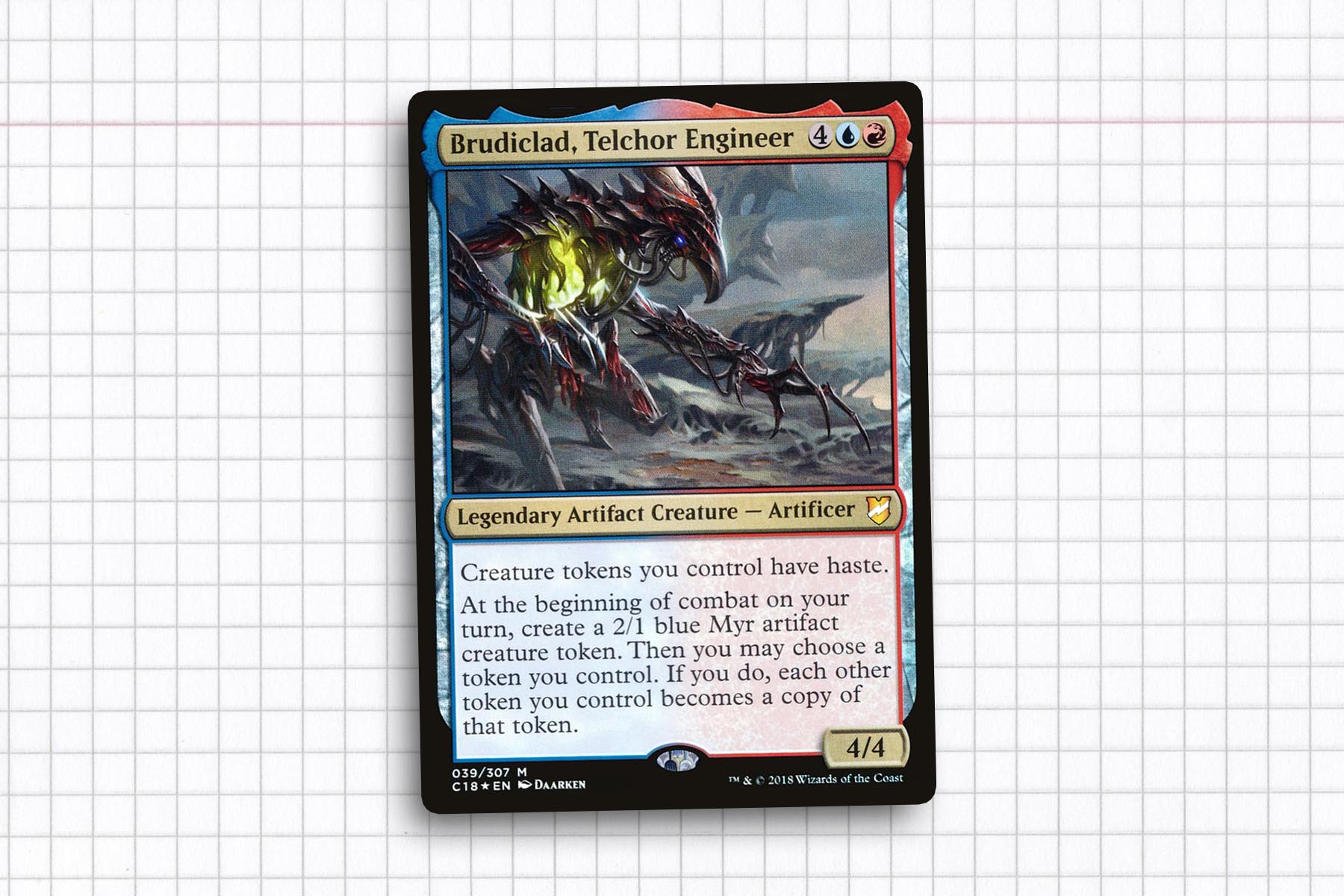
Commander: Brudiclad, Telchor Engineer
Creatures: Archetype of Aggression, Archetype of Imagination, Astral Dragon, Baeloth Barrityl, Entertainer, Bane of Bala Ged, Cephalid Facetaker, Combat Celebrant, Curiosity Crafter, Delina, Wild Mage, Ethereal Investigator, Faerie Artisans, Falkenrath Marauders, Feldon of the Third Path, Goldhound, Jaxis, the Troublemaker, Mirage Phalanx, Mogg War Marshal, Precursor Golem, Replication Specialist, Rionya, Fire Dancer, Tectonic Giant, Toggo, Goblin Weaponsmith, Ulamog’s Crusher
Artifacts: Fellwar Stone, Fire Diamond, Genesis Chamber, Helm of the Host, Izzet Signet, Mimic Vat, Sky Diamond, Skyclave Relic, Sol Ring, Talisman of Creativity, Thran Dynamo
Enchantments: Coastal Piracy, Determined Iteration, Feywild Visitor, Scuttletide, Splinter Twin, Storm the Vault
Planeswalkers: Saheeli Rai, Saheeli, Sublime Artificer
Instants: Access Denied, Big Score, Delayed Blast Fireball, Elminster’s Simulacrum, Flip the Switch, Perplexing Test, Prismari Command, Spell Swindle, Theoretical Duplication, Unexpected Windfall
Sorceries: Anger of the Gods, Blasphemous Act, Hard Evidence, Indulge // Excess, Irenicus’s Vile Duplication, Saheeli’s Artistry, Spiteful Repossession, Twinflame, Whelming Wave, Zndrsplt’s Judgment
Lands: 9 Island, 13 Mountain, Ash Barrens, Blasted Landscape, Command Tower, Desolate Lighthouse, Forgotten Cave, Halimar Depths, Highland Lake, Lonely Sandbar, Remote Isle, Silverbluff Bridge, Smoldering Crater, Sulfur Falls, Swiftwater Cliffs, Temple of Epiphany, Underdark Rift
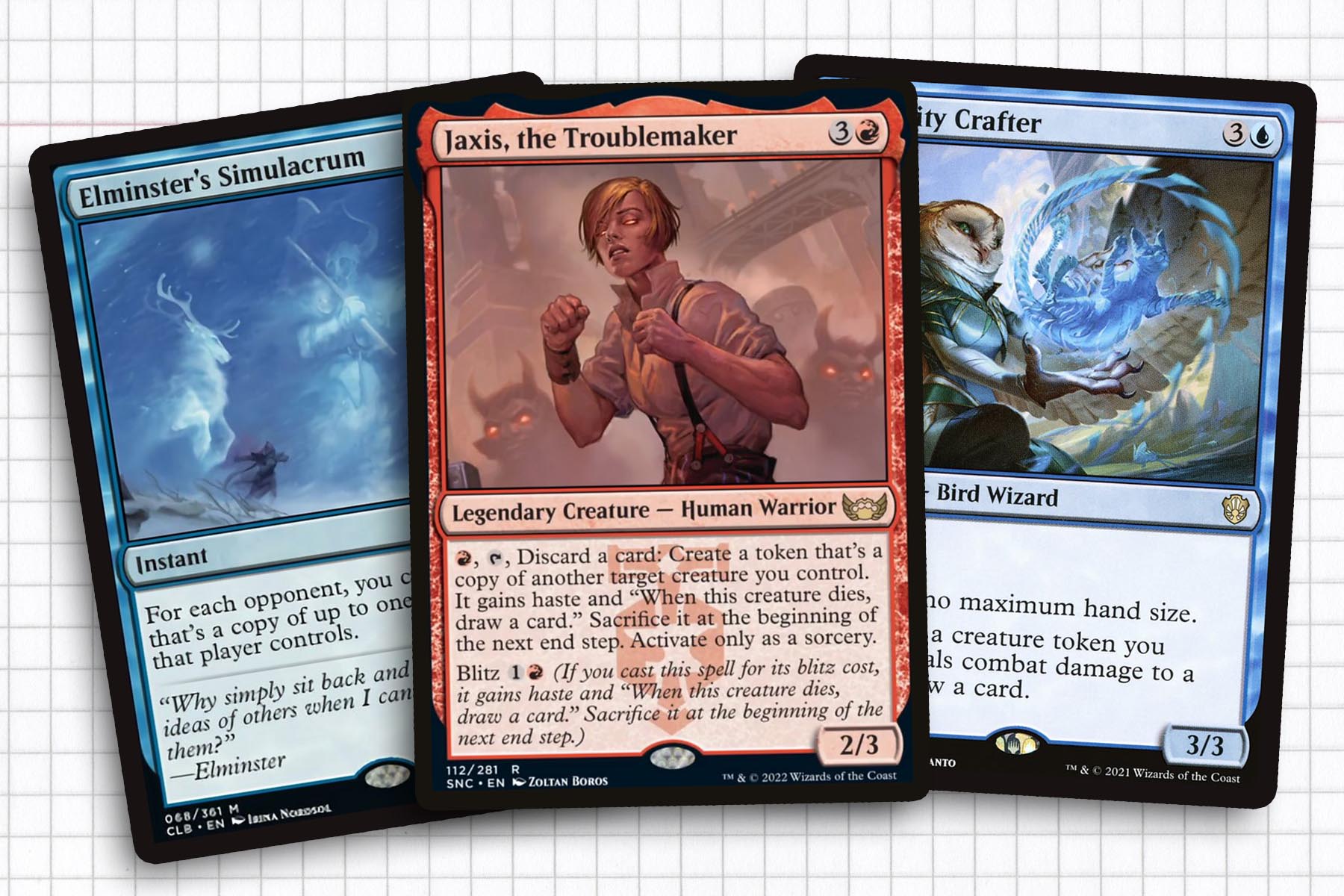
The Year That Was
One of the big pushes over the last year that has really had me coming back to Brudiclad on a regular basis is just the amount of stellar additions that have come out. I found myself starting to become really energized to iterate starting around Strixhaven, when inexplicably Izzet tokens started to get a lot of cards I was bookmarking in my mind. Curiosity Crafter and Rionya, Fire Dancer both immediately got my attention, the Crafter reading like a Green/White card that got snuck into Blue and Rionya wanting to be a more spell-focused deck, but crucially providing the single token needed to stack our triggers and allow us to mass clone any creature we control.
After letting Strixhaven settle in, I remember discovering Perplexing Test and soon saw it as the blue Hour of Reckoning, then identifying Theoretical Duplication as the perfect Gather Specimens variant for the deck. Then, at the tail end of 2021, I remember seeing reveals of Mirage Phalanx and Ethereal Investigator, both of which felt destined for the deck as well. Of the two, I think Ethereal Investigator may have been the more impactful inclusion, as it replaced Drownyard Explorers as an obvious upgrade and made use of token copy effects a lot more palatable.
And then this Spring saw the release of the Streets of New Capenna products, giving us Jaxis, the Troublemaker—whom we will highlight in a moment—Determined Iteration, and Spiteful Repossession. Determined Iteration brought an interesting twist to the populate mechanic that I hadn’t considered in the design space before, allowing for us to not only get an extra body every turn, but also another enter the battlefield effect for any creature cards we may have copied. Then we have Spiteful Repossession, which spoke to the lack of land ramp available to the deck, while also providing a damage outlet. Honestly, sometimes an extra three to five damage on any one player is enough to change the behavior of the table, while also not leaving me as the easy responsible party.
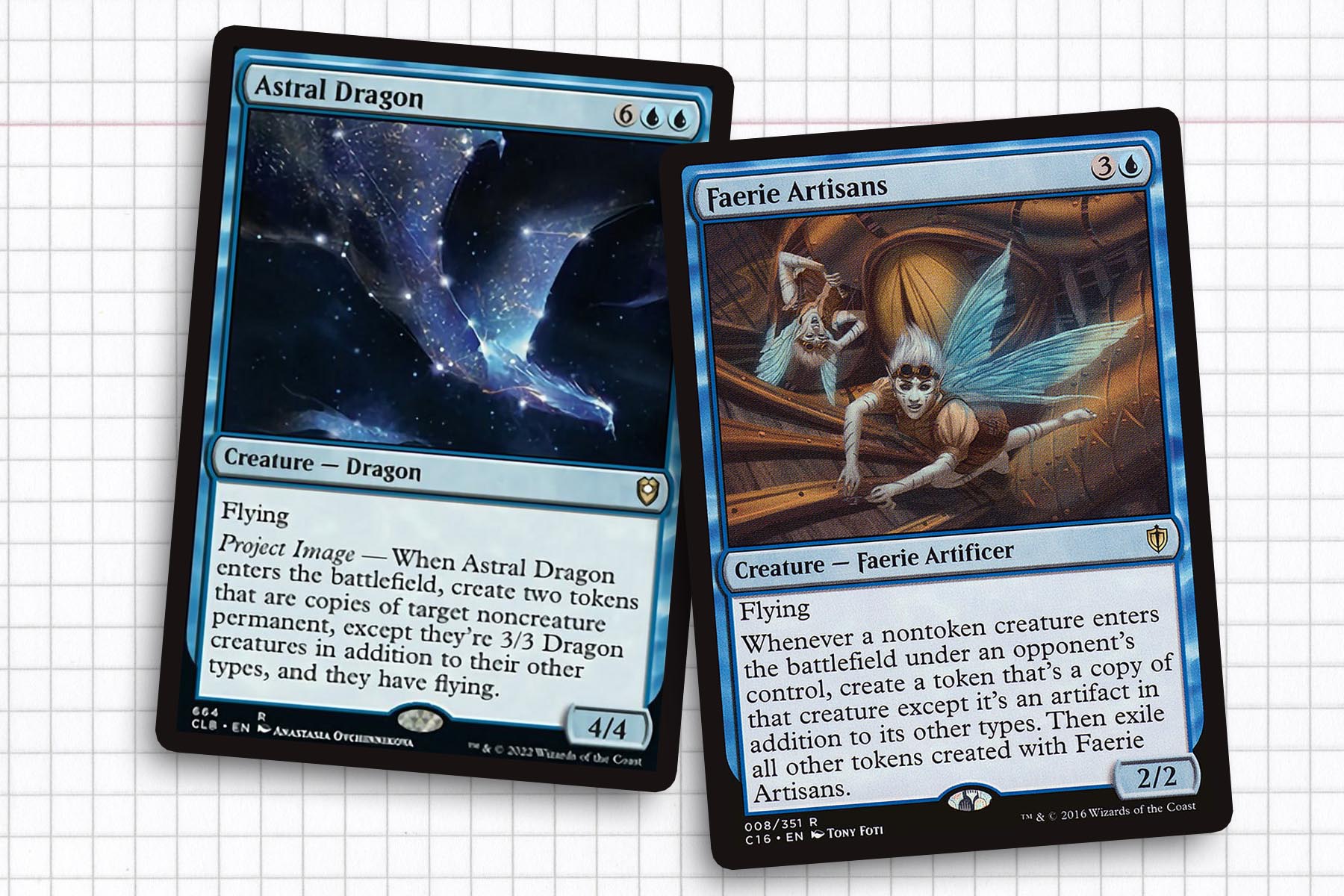
I Like What You Got There
The driving principle for this deck has been a desire to use our opponent’s board’s against them. Less so in the way something like Lazav, Dimir Mastermind tends to operate, instead taking advantage of Brudiclad’s unique design space to focus in on one permanent and make multiples of it, circumventing the normal conventions of the format. I will say, this strategy has been mildly hampered by Wizards’ choice to more commonly create powerful game pieces that also happen to be legendary, but it’s a risk that now comes with the territory.
It used to be that I was leaning hard on Faerie Artisans, Saheeli’s Artistry, and Zndrsplt’s Judgment to get this copying done; but once again, the last year has been very fruitful. I’ve already talked about how great Theoretical Duplication was for the deck, but Cephalid Facetaker was a ray of shine in a way I just wasn’t expecting. And the recent printing of Astral Dragon and Elminster’s Simulacrum has raised my hope that the core intent of this deck may finally be within my grasp, in a way that Clone Legion and Rite of Replication were no longer able to provide.
What I’ve really enjoyed about empowering this theme is that it often contradicts the expectations that a lot of players have when sitting across the table from it. For the most part you assume that Brudiclad is going to present its own threats which I will copy ad nauseam; while that is still a line of play, it is not the sole intention of the deck. My hope is that that is a refreshing change of pace for all parties involved. And once a facsimile of our opponents’ stuff becomes our stuff, we are ready for our second category of copy effects.
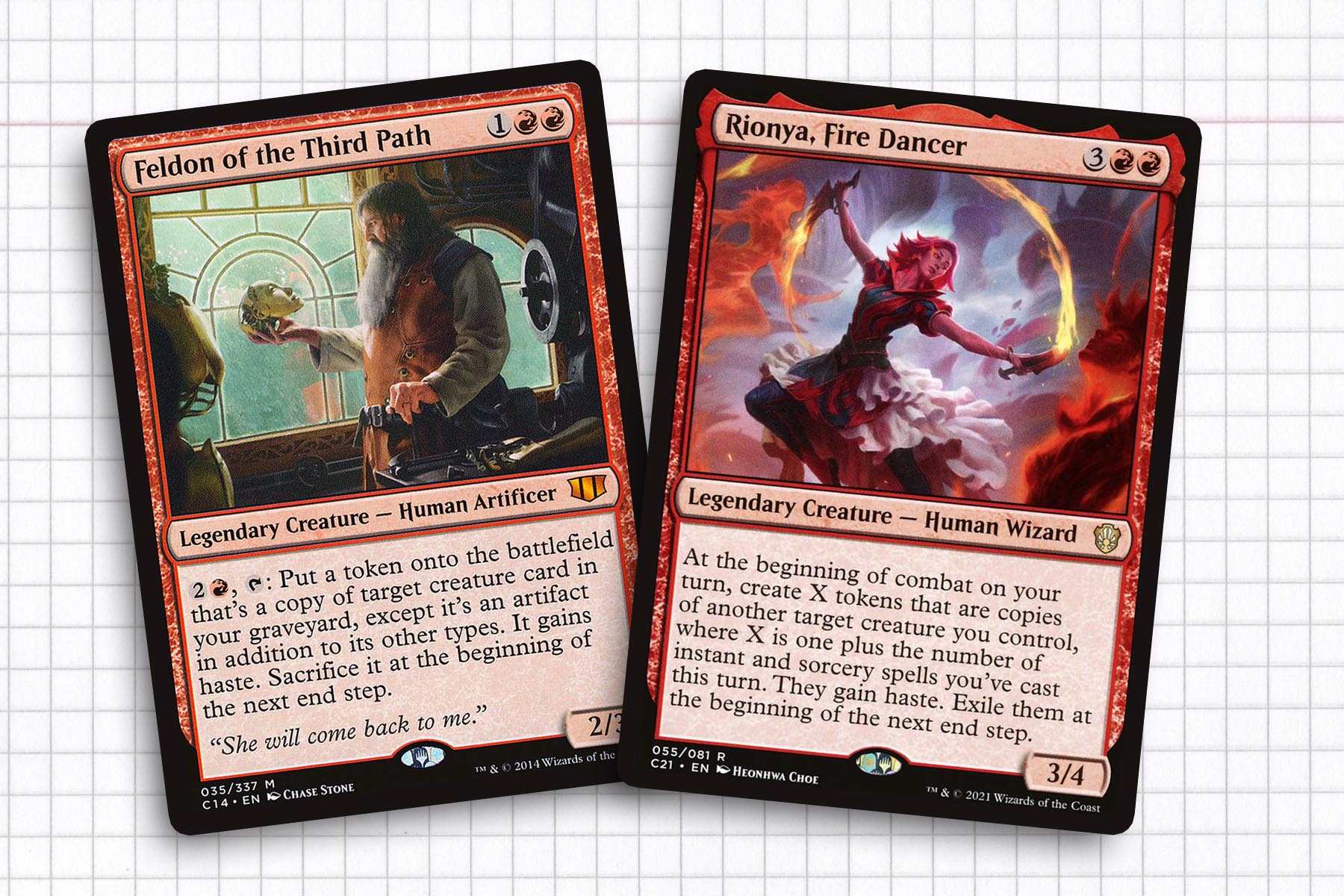
Multiplicity
There’s no doubt that one of the things that Brudiclad is known for most is their ability to take our prize array of tokens and turn them into a creature army at will. Of all the cards that have become marquee for this deck I would say the trio of Delina, Wild Mage, Jaxis, the Troublemaker, and Rionya, Fire Dancer have made a huge impact on the public perception of Brudiclad. All three play similar roles, they do have their high and low points. Delina does not have the timing needed to play right with Brudiclad, but acts a solid second in command, especially if we get Helm of the Host on them. Jaxis has some timing restrictions, but works well with our general and enables rummaging, as the copies will gain, “when this creature dies, draw a card” as long as they remain that token. And Rionya may require some additional rules knowledge on stacking triggers, but can be a blow out if we spent our mana on instant and sorcery spells that turn.
While we are certainly building our deck around our commander, I’ve found that sometimes Brudiclad acts a finisher more than a crucial key to every turn. We can often get away with casting them only once we’ve reached our key turn, transforming our token army into a specific permanent. Feldon of the Third Path and Mimic Vat are both classic Commander cards that have been a part of this deck from the beginning, their shared role is to make things that aren’t usually tokens into tokens with minimal effort. Most people look right at Combat Celebrant as the obvious combo card to copy, but I have really enjoyed the times I was able to turn all my tokens into Tectonic Giant to close out a game more directly.
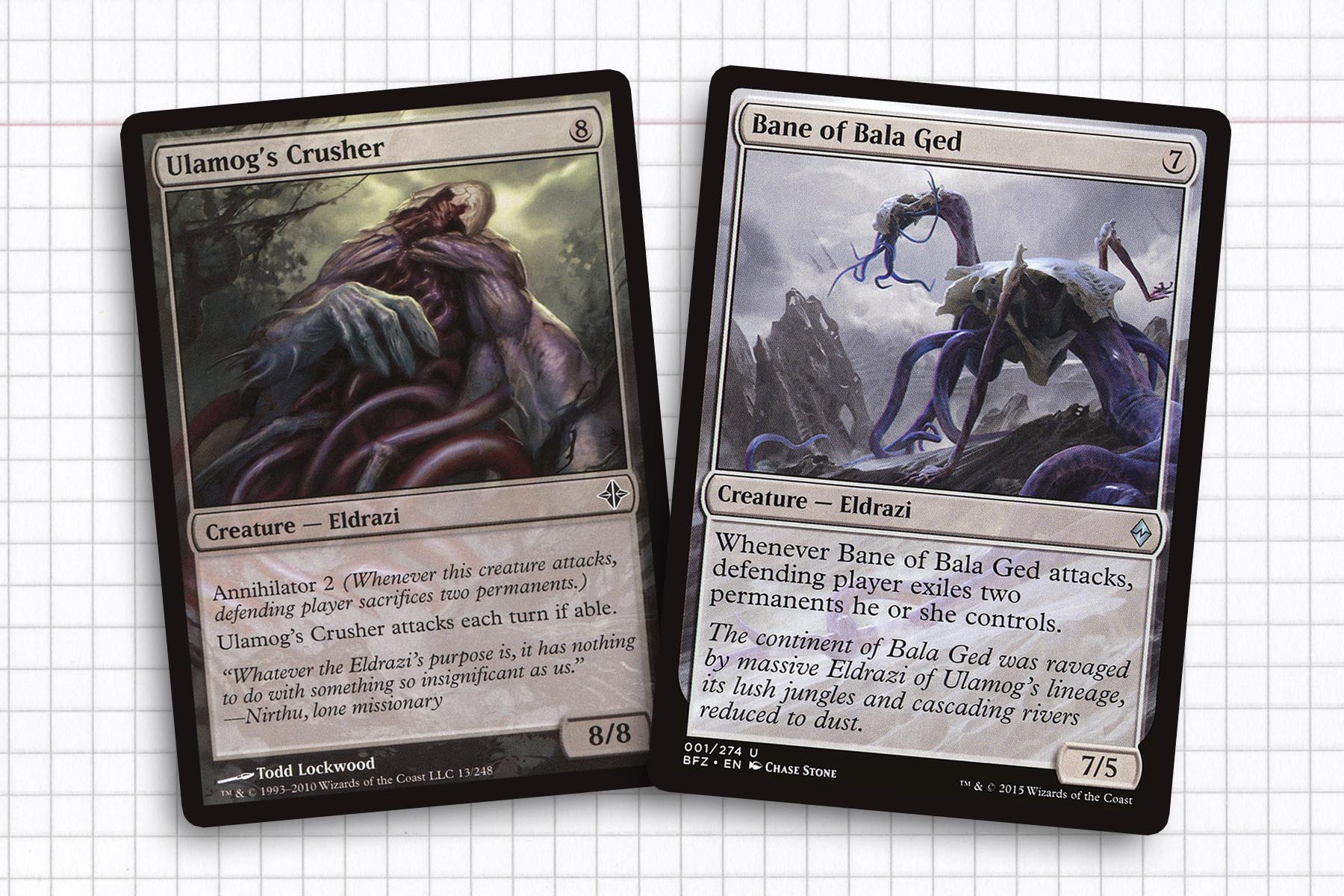
Win Conditions
Part of the fascination and freedom with decks like this is that you don’t necessarily need a strict win condition. A lot of fun can come out of taking the situations that are given to you and winning in ways that the deck would not normally be able to, simply because it is using the cards on hand from your opponents. That said, the three undercover creature win conditions within this deck are Bane of Bala Ged, Falkenrath Marauders, and Ulamog’s Crusher.
The Eldrazi probably speak for themselves; they were ideal within the context of this deck, because they are on the cheaper side and when they attack, they act as effective removal against our opponents. When we make creature tokens out of them, we may have an army of 10 to 15 that are all going to be using the same trigger. The idea to use eldrazi came from an early playtest where Faerie Artisans created a copy of It That Betrays, to the owner’s dismay. Falkenrath Marauders is a much more niche use case, but when we need it, we get a lot out of them. In the situations where we can hit with a lot of flying creatures, taking the turn to make our creature tokens into 2/2 fliers can mean that on a different turn, we will have bolstered versions of whatever our next shape may be.
Concluding Thoughts
In the end, this deck has proven to be a good reminder of the importance of allowing a deck to come into its own. When I originally wrote about this card four years ago, I envisioned a much different deck that was structured in a way that was, in all honesty, a little bulky and too gimmicky. I knew that the deck itself was possible, plenty of people were having success with it, but nothing really spoke to my own building philosophies until a higher saturation of token copy effects came into the game.
It’s hard to say when any deck will become a part of my usual rotation, but in the practice games that I have tested this out, I have been pretty pleased. The deck has been able to pull out a surprising amount of inexplicable wins and sometimes it just creates board states that make me laugh, which is something that I like to get out of Commander on a regular basis. I have yet to see the ceiling of what Brudiclad is capable of and I am looking forward to discovering it one day. Thank you for reading.
Ryan Sainio is a Graphic Designer who writes about EDH and the EDH community. He has been playing Magic: the Gathering since 7th Edition in 2002 and values flavorful and fun gameplay over competitively optimized decks.

